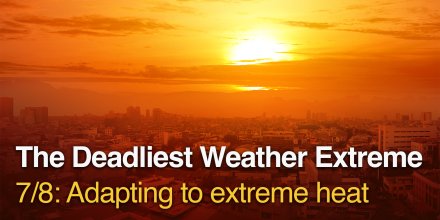
Webinar: Climate Data Tools for Resilient Urban Planning
This second webinar in the series presents digital tools that turn climate data into actionable strategies for urban resilience.


This second webinar in the series presents digital tools that turn climate data into actionable strategies for urban resilience.

Rising heat risks demand better planning, stronger warning systems, and targeted adaptation strategies.
|
|
|||||||||
|---|---|---|---|---|---|---|---|---|---|
|
Icon
|

|

|

|

|

|

|

|

|
|
|
Temperature (°F)
|
|||||||||
|
Temperature felt (°F)
|
74° |
73° |
80° |
88° |
88° |
84° |
80° |
76° |
|
|
Wind direction
|
W |
W |
WSW |
WSW |
W |
WNW |
W |
NW |
|
|
Wind speed (mph)
|
W
2-6
2-6
|
W
2-9
2-9
|
WSW
6-12
6-12
|
WSW
6-13
6-13
|
W
5-12
5-12
|
WNW
3-8
3-8
|
W
3-7
3-7
|
NW
3-8
3-8
|
|
|
Precipitation (in/3h)
|
-
0%
-
|
-
0%
-
|
-
0%
-
|
-
0%
-
|
-
0%
-
|
-
0%
-
|
-
0%
-
|
-
0%
-
|
|
|
Precipitation probability
|
0%
|
0%
|
0%
|
0%
|
0%
|
0%
|
0%
|
0%
|
|
|
Precipitation hourly
|
|||||||||
|
Precipitation hourly
|
No precipitation expected |
||||||||
|
rainSPOT
Precipitation distribution within 20 km
|
|
||||||||
Overnight into Sunday the sky remains overcast, but most clouds give way on Sunday morning. Sunday afternoon clear skies prevail. It is a sunny day. Temperatures peaking at 85 °F. The UV-Index climbs up to 10, don't forget to use sunscreen when spending the day outside. Overnight into Sunday light air is noticeable (1 to 4 mph). In the course of day blows a light breeze (4 to 8 mph). Winds blowing from West. The weather forecast for Zalangoye for Sunday is expected to be very accurate.
Pressure: 1012 hPa
Timezone: WAT (UTC +01:00h)
By comparing today's temperatures to 40 years of historical data we can see whether today's forecast is unusually warm (red areas) or cold (blue areas). Coloured dots show observed actual temperatures from professional and private weather stations.
The real-time satellite image combines visible light during daytime with infrared radiation during nighttime. At night, the image is not dark as infrared radiation can detect temperature differences. Unfortunately, low clouds and fog are difficult to distinguish from ground temperatures and thus can be almost invisible during the night. Meteosat satellite images for Europe are updated in real-time every 5 minutes. GOES-16/GOES-17 (North & South America) and Himawari (Asia) images update every 10 minutes.
Precipitation is estimated from radar and satellites. Precipitation estimates from satellites are less accurate at night than during daytime.
© 2025 meteoblue, NOAA Satellites GOES-16 and EUMETSAT. Lightning data provided by nowcast.
The location marker is placed on Zalangoye. Orange crosses indicate lightning. Data provided by nowcast.de (available in USA, Europe, Australia). Drizzle or light snow fall might be invisible for the radar. Precipitation intensity is colour coded, ranging from turquoise to red.

This second webinar in the series presents digital tools that turn climate data into actionable strategies for urban resilience.

Rising heat risks demand better planning, stronger warning systems, and targeted adaptation strategies.
Advertising is essential to maintain our free website with unique detail and accuracy.
Please whitelist www.meteoblue.com on your ad blocker or consider buying one of our products:
Already have a subscription?
Then please login.